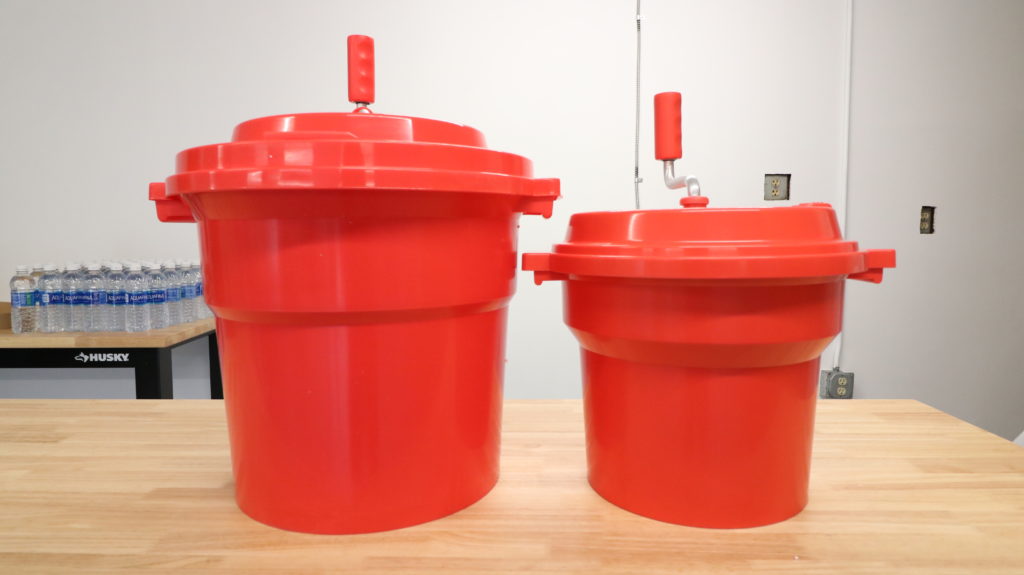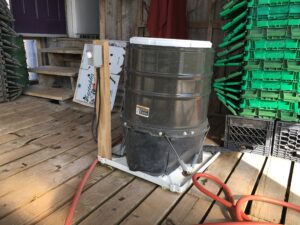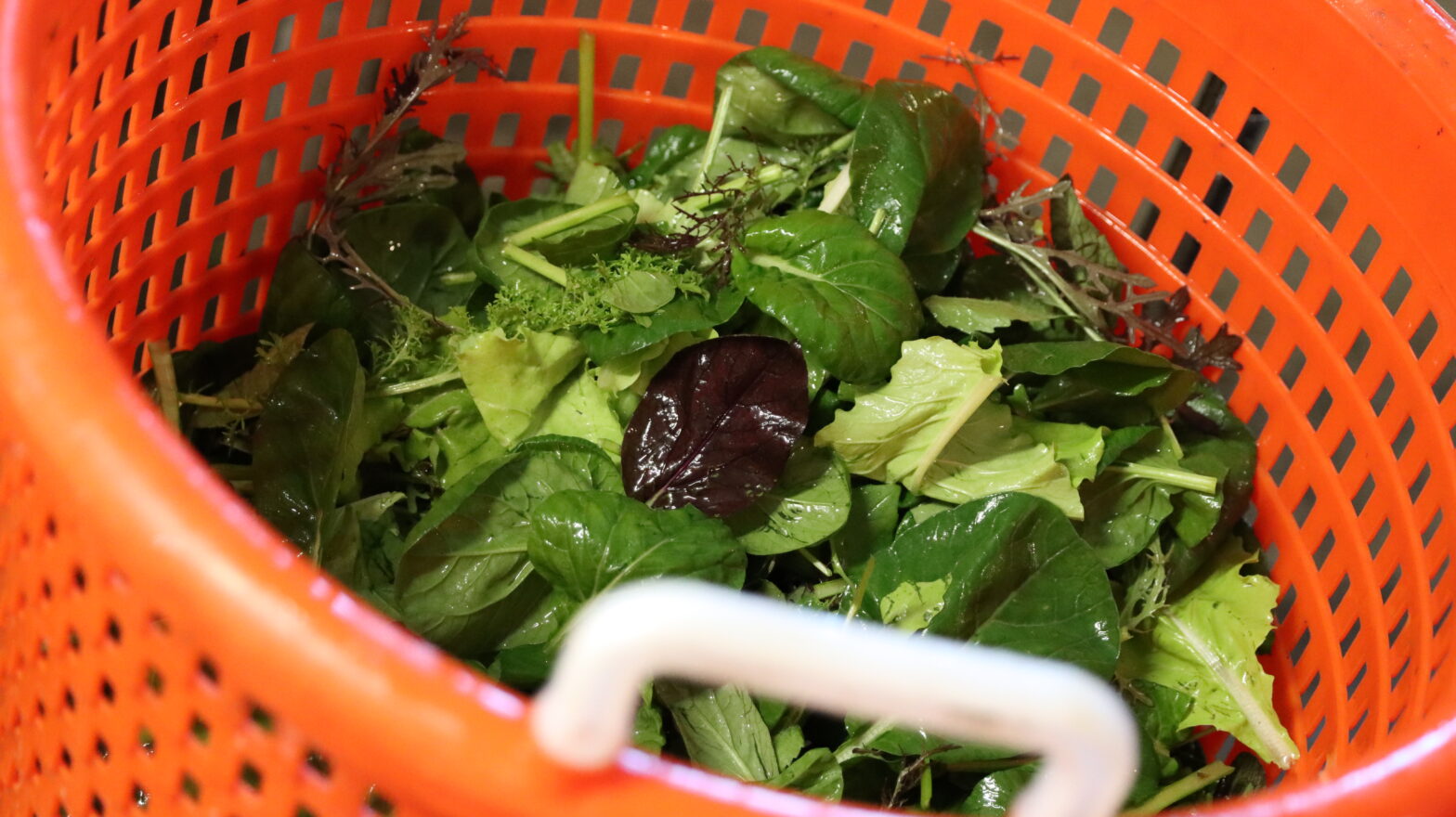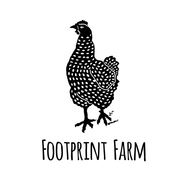![]() Download the PDF Fact Sheet Here!
Download the PDF Fact Sheet Here!
Introduction

An important factor in growing and selling high-quality salad greens is being able to efficiently wash, cool, and dry the product. The drying step is commonly done using centrifugal force in a spinner. The water is spun off of the greens through a filter basket or other porous container. Some growers use mesh bags to contain the greens and improve the efficiency of loading and unloading the spinner.
Some of the key features to consider when thinking about a spinner include cost, capacity, power, space and sanitary design are as follows.
Cost
There is a broad range of spinners available and they vary considerably in cost. Your budget may dictate which option you choose. But, consider the other features below as well. For example, a less expensive, converted washing machine spinner may actually cost more in cleaning labor when compared to a machine designed to be cleaned.
Capacity
How big is each batch or how much do you need to dry in a day? Keep in mind that a 5-gallon spinner cannot adequately dry 5 gallons of greens since there needs to be room for the greens to spread out and not create an overly thick mat that water can’t get through. A rough rule of thumb is 1.1 gal of spinner volume for 1.0 lb of greens.
Power
Do you require an electric driven spinner? Can you do this step manually? Is there a significant labor efficiency or consistent quality gain in having an automatically timed spin cycle?
Space
Can you allocate the floor space for a fixed piece of equipment? Can you put it on wheels? Would several hand spinners, which could be stored on a shelf, suffice when needed? Does the spinner have a drain and how will you dispose of the grey water safely?
Sanitary Design
How cleanable is the design? Are there nooks and crannies that may result in harborage of water, soil, and pathogens? Can you wash all interior surfaces well with an appropriate detergent? Can you apply an anti-microbial solution (aka sanitizer)? Will the unit be able to dry completely between uses?
In the following section, a variety of manual and electric greens spinners are summarized.
Manual Spinners
$25 – $220, 1 – 5 lbs batch capacity

Manual greens spinners generally take the form of a solid outside drum, an inner mesh drum, and a lid with a spinning handle. These are typically offered in 2.5 and 5.0-gallon sizes with or without a manual brake.
The 2.5-gallon spinners can accommodate the equivalent of 4 heads of lettuce (about 3.5 lbs), while the 5.0-gallon spinners accommodate the equivalent of 8 heads (4.5 lbs). The spinning handle is connected to gears that convert the handle speed to a higher basket speed. Some designs are “sealed”, meaning the drive gears are covered on the inside to make cleanup easier. Additional inner baskets can be purchased to allow for a more efficient wash/pack process. One basket can be filled while one is in the spinner and another is being packed after spinning. Some manual spinners include a drain line to direct water out of the outer drum which can save time between batches.
- <1.0 gal Home Kitchen Salad Spinners – Wide Variety of Options, $25-50 – Web Link
- Johnny’s / Dynamic Salad Spinner – 1 Gal – $109 – Web Link
- Choice 2.5 gal Manual Spinner – $99 – Web Link
- Choice 5.0 gal Manual Spinner – $110 – Web Link
- Chef Master 5.0 gal Manual Spinner with Brake – $159 – Web Link
- Johnny’s / Dynamic 2.5 gal Manual Spinner – $161 – Web Link
- Johnny’s / Dynamic 5.0 gal Sealed Manual Spinner – $220 – Web Link
- Johnny’s / Dynamic 5.0 gal Manual Spinner – $195 – Web Link
Washing Machine Conversions
$600-1700, 5-10lb or 10gallon Capacity
Some farms find themselves stuck in the middle, where inexpensive, small-scale spinners cause a bottleneck, but it is hard to justify a more expensive industrial, stainless, restaurant-style machine. We have developed standard operating procedures for washing machine conversions of three specific models outlined in our Washing Machine/Greens Spinner Conversion Guide.
And you may also want to review the shopping guidance we have developed to make sure you’re looking for the right features.
The FSMA Produce Safety Rule states that “You must inspect, maintain, and clean and, when necessary and appropriate, sanitize all food contact surfaces of equipment and tools used in covered activities as frequently as reasonably necessary to protect against contamination of covered produce.” [§112.123(d)(1)]
This seems simple, but the rule also highlights the challenges with washing machines when it states “You must use equipment and tools that are of adequate design, construction, and workmanship to enable them to be adequately cleaned and properly maintained…” [§112.123(a)] and “Seams on food contact surfaces of equipment and tools that you use must be either smoothly bonded, or maintained to minimize accumulation of dirt, filth, food particles, and organic material and thus minimize the opportunity for harborage or growth of microorganisms.” [§112.123(c)]
The rule does not prohibit washing machines as greens spinners. This is where the Produce Safety Rule has built-in flexibility, supporting the adoption of safe principles but not forcing specific practices, as long as the risks can be minimized.
A few key points to consider regarding washing machine spinners are summarized below.
Drum and Drain
If you use a modified washing machine for drying greens, clean the drum and keep it clean. A new washing machine is more expensive, but at least you know its history. Direct the drain somewhere intentionally away from the immediate washing area and preferably into a fixed building drain. This drain should be plumbed outside of the wash/pack area, away from food production areas and bodies of water.
Cleanability, Portability and Access

Consider removing as much of the outside paneling as possible to prevent harborage points for water and pathogens, to provide access for cleaning, and to provide for airflow to dry surfaces completely after cleaning. Bear in mind that the paneling is there to prevent access and by removing it, you may also be exposing rotating parts. Be sure you and your employees are aware of the safety risk posed by modifications and take care when operating the machine. Use a timer to limit the cycle and shut the machine down automatically when done. This prevents someone having to approach the machine while it is spinning. Also be sure to check for sharp edges and possibly break or deburr any sheet metal edges with a file if there is a chance of injury. Also take care to make sure electrical connections are protected from water intrusion.
Basket Inserts

Consider using a basket insert instead of placing your greens directly into the washer loose or in a bag. This is an efficiency improvement by handling the greens in a container and it provides another barrier of protection from potential contamination. The removable basket becomes the primary food contact surface, not the washer. The basket is easier to maintain, clean, sanitize, and dry. Two inserts have been found by growers to work especially well due to the way they fit in the opening of the machine.
- 1-¼ Bushel Mesh Basket – Item #OB125 from Rainflo and others. $17. These are the orange baskets usually with white handles, sometimes referred to as “fish baskets” or “crab baskets” and available from several sources. These are already a mesh and do not require drilling any holes.
- 20 gallon Rubbermaid Ingredient Container. Item #69020CLWHKIT. Available from Westaurant.com, ULINE, and others. $32-35. Downside is you will need to drill holes for drainage and clean up any rough edges.
Electric Spinners
$800 – 4300, 8 – 26 lbs batch capacity
Electric spinners offer the convenience of being driven by a motor instead of by a person. This frees up labor to focus on other supportive tasks such as washing or packing. The use of a motor also enables control of speed (RPM) and duration of spin cycle. Most electrically driven spinners offer the ability to set a timer or choose a specific spin cycle. These spinners are designed to be cleaned and are made of smooth and cleanable materials such as plastic or stainless steel. Most of these spinners are on wheels with locking casters which allows portability. Some have been designed to with the wheels spread out along a larger radius or with a lower overall height to improve stability.
- Johnny’s Dynamic Electric Salad Spinner – $810—Web Link
- Delfield SALD-1 Salad Dryer 20 Gallons – $3,626—Web Link
- Sammic ES-100 Electric Spinner – 13 lb, 10 gal – $2,992 – Web Link
- Electrolux VP2 “Green’s Machine” – 20 gal – $2,772 – Web Link
- Hobart SDPE-11 20 Gallon Polyethylene Salad Dryer – $2,895 – Web Link
- Hobart SDPS-11 20 Gallon Stainless Steel Salad Dryer – $3,757 – Web Link
- Sammic ES-200 Electric Spinner – 26.5 lbs, 20 gal – $4,280 – Web Link
Jericho Settlers Farm utilizes an industrial spinner as part of their wash line and you can see it in action in this video.
Keeping it Clean
Create a standard operating procedure (SOP) for cleaning the spinner after use. This might include:
- Unplug the machine.
- Disconnect drain unless the drain is needed as part of the cleaning process.
- When spraying any equipment or parts with water, avoid high-pressure sprayers or other high-velocity water inside the wash/pack area to minimize the potential for cross-contamination from “aerosolization” (projecting tiny water droplets into the air).
- Remember that the FSMA Produce Safety Rule requires that water used for postharvest applications (such as cleaning a greens spinner) contain no detectable generic e. Coli in a 100 mL sample. [§112.44]
- Remove basket insert, remove any visible dirt, debris, and remaining greens, and wash thoroughly with an appropriate detergent. Consider applying an anti-microbial solution to the insert in accordance with its label. Allow to thoroughly dry.
- Remove visible dirt, debris and remaining greens from the spinner. Wash all surfaces and places where food or water may contact thoroughly to prevent the build-up of biofilms. Consider applying an anti-microbial solution (a.k.a. sanitizer) in accordance with its label. Allow to thoroughly dry.
- Document the cleaning date, time and person who did the cleaning.
- You may also want to apply this SOP prior to washing if the machine is stored outside or in other areas where rodents, birds or other animals could contaminate it.
Farmer Feedback
Taylor and Jake of Footprint farm in Starksboro, VT are users of a washing machine conversion. They found that after spinning 30lbs of greens a week, it was both too time-consuming and exhausting for their growing farm.
They decided to invest in a new washing machine to convert into a spinner, and that $600 investment, paid for its self within the 1st week.
Throughput: From starting to fill the tubs with water, triple washing, spin drying, packing into 5lb boxes and placing in the cooler they can move 47.5lbs of greens/hr
A downside to the design: It’s loud because the baskets don’t fit perfectly and you can’t close the lid if you keep the handles on the baskets.
*Having a lid is nice to close at the end of the day to help keep it clean.
Shelf life improvement: Greens can last up to two weeks because they get dried so well.
Cleanability: It can be difficult to clean between the drum and the outside of the machine, but when on a concrete floor, it’s fairly easy to spray it out and let it dry.
Final Thoughts: Installing a timer improved the workflow, and didn’t require as close attention.
Share this post
Acknowledgments
Funding for this publication was made possible, in part, by the USDA Northeast Sustainable Agriculture Research and Education program through award LNE19-375, by the Food and Drug Administration through The Vermont Agency of Agriculture Food and Markets via the Integrated Extension Educational Programming in Support of the VAAFM Produce Program Grant 02200-FSMA-2018-01. The views expressed in the publication do not necessarily reflect the official policies of the U.S. Department of Agriculture, the U.S. Department of Health and Human Services or the Vermont Agency of Agriculture; nor does any mention of trade names, commercial practices, or organization imply endorsement by the United States Government or the State of Vermont.



